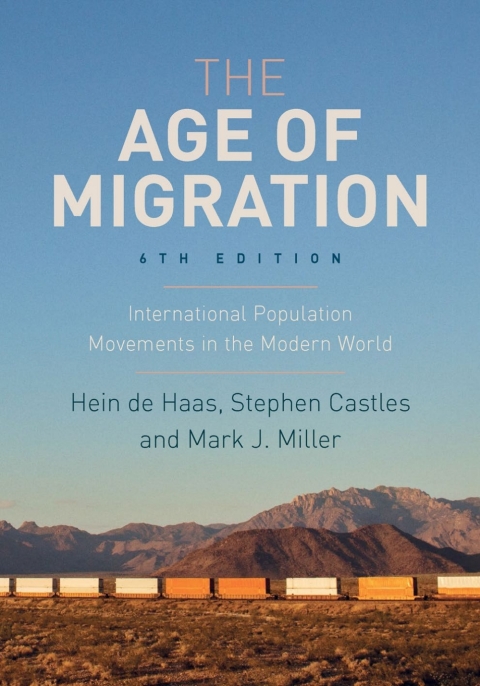Description
Efnisyfirlit
- Contents
- List of Figures
- List of Tables
- List of Maps
- List of Boxes
- Preface to the Sixth Edition
- Note on Migration Statistics
- The Age of Migration Website
- List of Abbreviations
- 1 Introduction
- Migration in an age of globalization
- The growth and diversity of international migration
- Trends and patterns of global migration
- The challenges of international migration
- International migration in global governance
- Aims and argument of the book
- Structure of the book
- 2 Categories of Migration
- Defining migration and human mobility
- Internal and international migration
- Temporary and permanent migration
- Origin and destination
- Migration motives: Labour, family, study, business
- Forced migration: Refugees and asylum seekers
- Illegal, unauthorized, irregular, undocumented
- Smuggling and trafficking
- Climate refugees: The construction of a migration threat
- Conclusion
- 3 Theories of Migration
- Explaining the migratory process
- Functionalist theories
- Historical–structural theories
- Conceptualizing migratory agency
- Dual labour market
- New economics and household theory approaches
- Migration transition theories
- The aspirations-capabilities model
- The internal dynamics of migration processes
- Migration systems theory
- Conclusion
- 4 Migration, Ethnicity and Identity
- The formation of ethnic minorities
- Ethnicity
- Race and racism
- Gender and migration
- Culture and identity
- Transnationalism and diaspora formation
- State and nation
- Citizenship
- Conclusion
- 5 International Migration before 1945
- Migration during European imperialism
- Settlement and creolization
- Industrialization and trans-Atlantic migration
- Labour migration within Europe until 1914
- The interwar period: Protectionism, nativism and racism
- The Second World War, forced labour and genocide
- Conclusion
- 6 Migration in Europe since 1945
- Migration in the post-war boom (1945–1973)
- Settlement and the growth of dual labour markets (1973–1989)
- Migration during neoliberal globalization (1989–2008)
- Migration in the former Soviet space
- The EU and Schengen: Expansion and integration
- Southern European migration transitions
- The politicization of migration and the ‘global race for talent’
- Migration after 2008: Destination Europe
- Conclusion
- 7 Migration in the Americas
- Regional migration patterns
- America’s migration transition (1945–1973)
- The globalization of American immigration (1973–1989)
- An elusive quest for control? American migration since 1989
- Canada: A quintessential immigration country
- Social transformation and migration in Latin America
- Recent developments in the US: A backlash against diversity?
- Conclusion
- 8 Migration in the Asia-Pacific Region
- Colonial and post-colonial migration patterns
- The entry of Asia on the global migration stage (1973–1989)
- The globalization of Asian migration (1989–2008)
- The rise of Asian migration destinations
- Migration since 2008: Consolidation and expansion
- The changing geographies of Asia-Pacific migration
- Migration in Australia and New Zealand
- Conclusion
- 9 Migration in Africa and the Middle East
- The historical roots of contemporary African migrations
- Postcolonial and guestworker migration (1945–1973)
- Intraregional migration: Conflict, urbanization and economic transformation
- The rise of the Gulf as a global migration magnet (1973–1989)
- African migration in the post-Cold War era
- Social transformation, the Arab Spring and migration
- The entry of Africa on the global migration stage
- Conclusion
- 10 The State, Politics and Migration
- The exit revolution
- Migration, diplomacy and state power
- The securitization of migration
- The construction of an ‘Islamic threat’
- Is xenophobia really on the rise?
- Multilateral migration governance: A cul-de-sac?
- The European Union’s migration regime
- The international refugee regime
- Conclusion
- 11 The Evolution and Effectiveness of Migration Policies
- Migration policy categories
- The migration policy toolbox
- Between rhetoric and practice
- The liberalization of migration policies
- The liberal paradox
- Travel visas and the prevention of unwanted migration
- The enforcement challenge
- Legalization: Policy failure or policy tool?
- Unintended consequence of migration policies
- Conclusion
- Appendix: The migration policy toolbox
- 12 Migrants and Minorities in the Labour Force
- The social construction of labour needs
- The changing structure of labour demand
- Migrants in the labour market
- Migrant entrepreneurship
- The transformation of work
- The feminization of precarious work
- The chronic demand for migrant labour
- The continued importance of labour recruitment
- Conclusion
- 13 New Ethnic Minorities and Society
- Immigration policies and minority formation
- Residential segregation
- Migration and the global city
- Integration policies: A controversial issue
- Racism and minority formation
- Citizenship acquisition
- Linguistic and cultural rights
- Immigrants and nation
- Models of immigrant integration
- Conclusion
- 14 Migration and Development in Origin Societies
- The migration and development debate
- Remittances as development aid?
- The economic impacts of migration and remittances
- Brain drain or brain gain?
- Social remittances
- Reform as a condition for migration and development
- Policy implications
- Conclusion
- 15 Conclusion
- Future perspectives for global migration and mobility
- Improving international cooperation and governance
- Responding to irregular migration
- Legal migration and integration
- Ethnic diversity, social change and the nation state
- Glossary
- Bibliography
- Index






Reviews
There are no reviews yet.